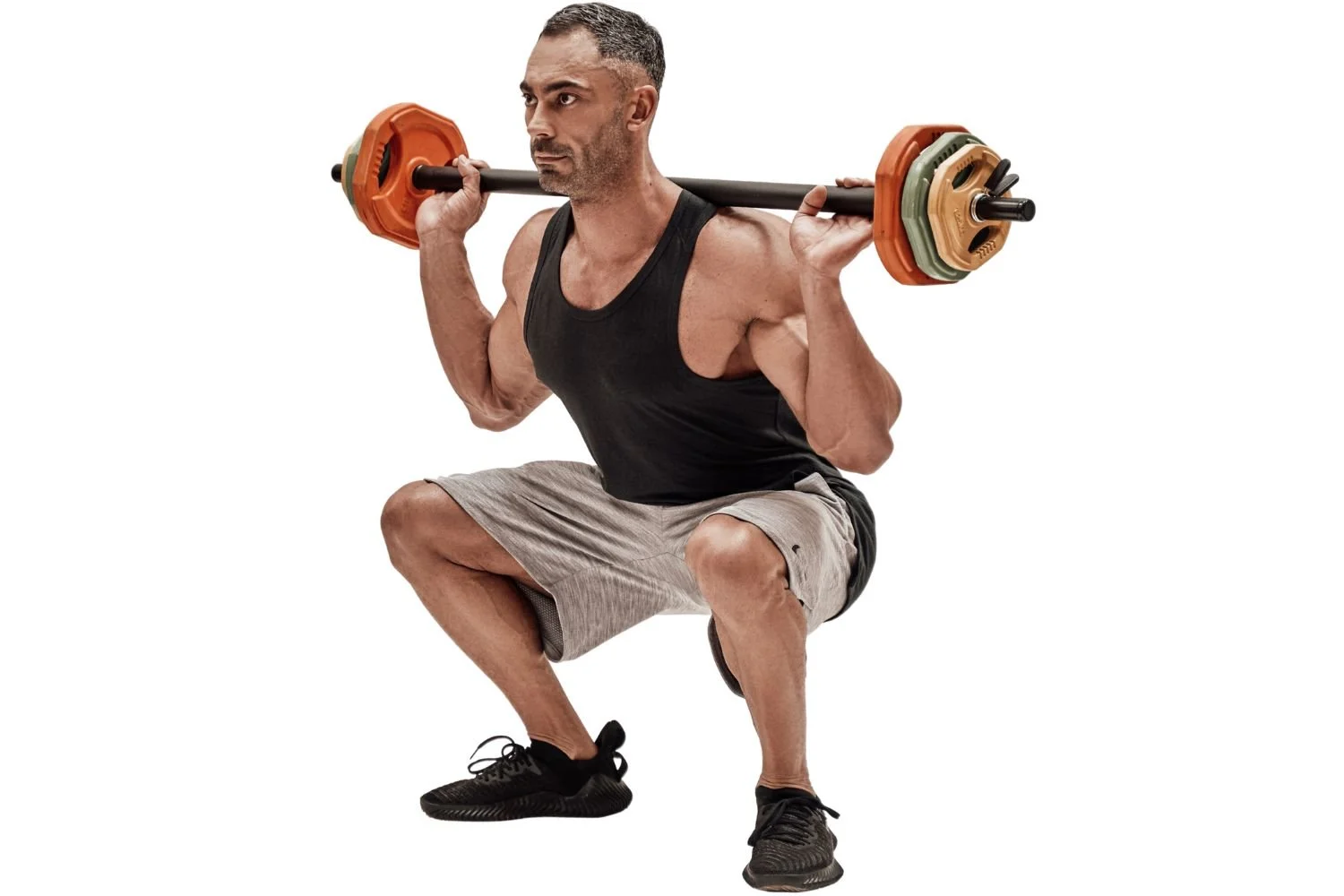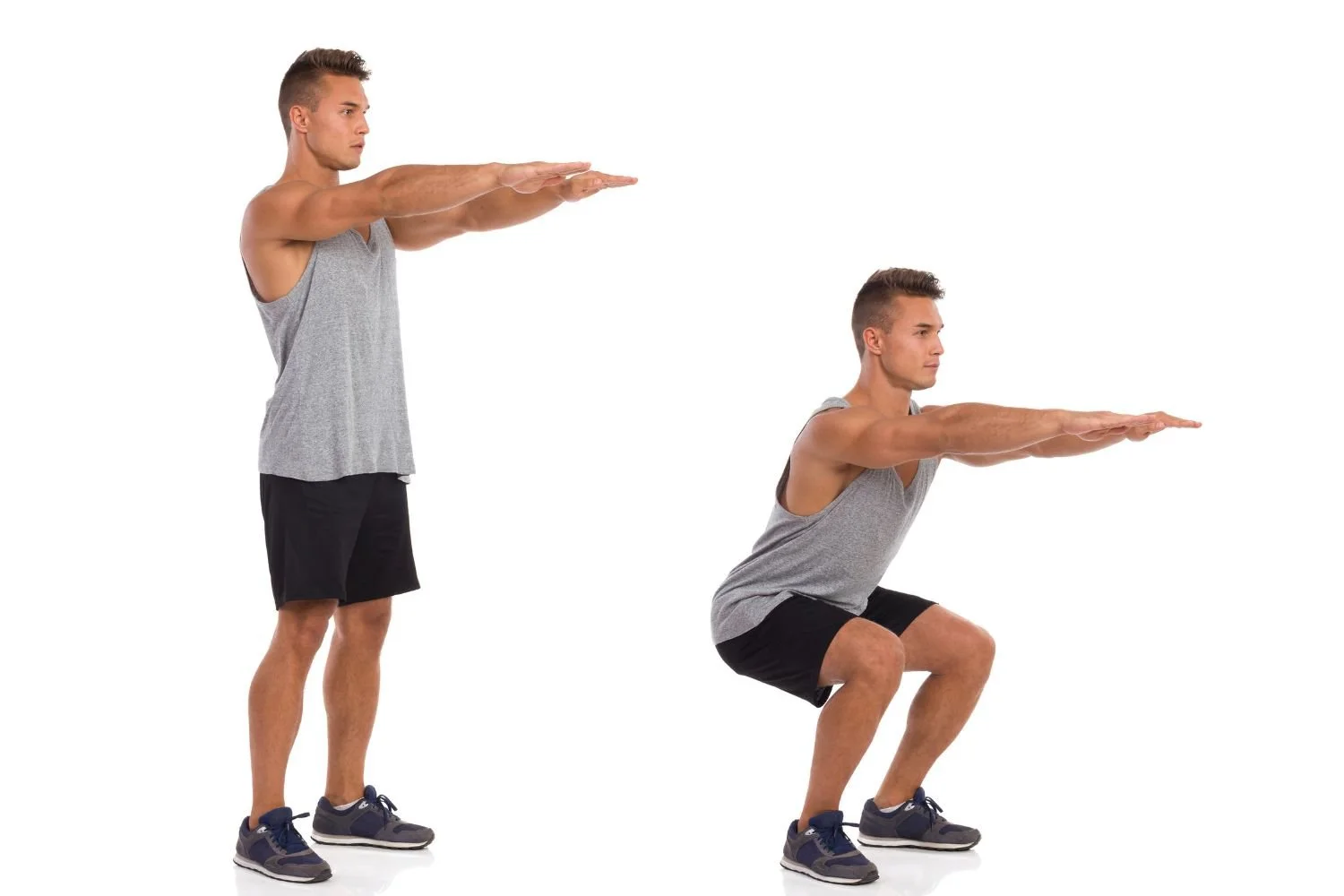The Squat: The Foundation of Strength, Power, and Functional Fitness.
Few movements in fitness command as much respect as the squat. Often hailed as the king of all exercises, the squat is a cornerstone of strength training, functional fitness, and athletic performance. Whether performed with body weight, barbells, or resistance bands, the squat remains one of the most powerful tools for building muscle, improving mobility, and enhancing overall physical health.
What Muscles Does the Squat Work?
The squat is a compound exercise, meaning it recruits multiple joints and muscle groups simultaneously. While it’s often associated with building strong legs, its impact extends well beyond the lower body.
Quadriceps (front thighs):
The primary movers during the upward phase, the quads extend the knee and provide power as the body rises.
Gluteus Maximus (buttocks):
Engaged heavily at the bottom of the movement, the glutes are responsible for hip extension and overall lower-body power.
Hamstrings (back thighs):
These muscles stabilize the knees and assist in hip extension, balancing the strength of the quadriceps.
Calves (gastrocnemius and soleus):
Support the ankle joint and help with stability during the movement.
Core muscles (abdominals, obliques, erector spinae):
Engage to stabilize the spine and prevent forward collapse, making the squat as much a core exercise as a leg exercise.
Upper back and shoulders:
Particularly in weighted squats, the traps and deltoids assist in maintaining an upright posture and supporting the barbell.
The squat isn’t just a leg movement—it’s a full-body coordination exercise that challenges stability, balance, and control.
Bottoms-up kettlebell press — maintain a firm grip, stable wrist, and engaged core to control the weight and build shoulder stability.
The Benefits of Squatting
Squats offer a wide range of physical and physiological benefits, making them a foundational element in nearly every training program.
Muscle Growth and Strength Development
Squats stimulate large muscle groups, triggering a powerful anabolic response. This leads to increased muscle mass, especially in the legs and glutes, and contributes to overall body strength. Because the squat engages so many muscles, it also encourages the release of hormones like testosterone and growth hormone—key drivers of muscle development.
Improved Athletic Performance
For athletes, squats are essential for improving sprint speed, jump height, and overall lower-body power. A strong squat translates into better acceleration, deceleration, and change of direction in nearly every sport—from football to basketball to running.
Functional Strength for Everyday Life
The squat is one of the most functional exercises a person can perform. It mimics everyday actions like sitting down, standing up, or lifting objects from the ground. By training the body to move efficiently under load, squats reduce the risk of injury during daily tasks and physical activities.
Enhanced Core Stability and Posture
A properly executed squat strengthens the core and postural muscles, improving spinal alignment and reducing back pain. It trains the body to brace under load—a skill vital for both athletic movements and safe lifting in daily life.
Metabolic and Cardiovascular Benefits
Because squats engage such a large number of muscles, they elevate heart rate and calorie expenditure. Incorporating squats into a workout routine can aid in fat loss, improve cardiovascular endurance, and enhance metabolic efficiency.
Joint Health and Mobility
Contrary to common myths, squats—when performed with correct form—improve knee and hip health. Deep squats encourage greater range of motion, lubricate joints, and strengthen connective tissues.
A True Functional Exercise
A functional exercise is one that enhances movements performed in daily life. The squat fits this definition perfectly. Humans naturally squat from childhood—it’s how we sit, lift, and stabilize our bodies. Training the squat not only improves physical strength but also reinforces proper movement mechanics that protect the body from injury.
In rehabilitation and physical therapy, squats are often used to restore functional mobility, particularly for the elderly or those recovering from lower-body injuries. For younger and athletic populations, squatting builds the foundation for nearly every athletic movement—running, jumping, pivoting, and even throwing all stem from lower-body strength and core stability developed through squatting.
Bottom position of the barbell back squat — maintain core tension, keep heels down, and drive through the floor to return to standing.
Variations of the Squat
To meet different training goals and experience levels, there are numerous squat variations. Some of the most common include:
Bodyweight Squat:
Ideal for beginners, focusing on form, mobility, and control.
Goblet Squat:
Performed with a dumbbell or kettlebell held at the chest to teach proper depth and posture.
Barbell Back Squat:
A classic strength-building movement that targets the posterior chain and builds maximal power.
Front Squat:
Places greater emphasis on the quadriceps and core stability.
Sumo or Wide-Stance Squat:
Shifts focus to the inner thighs and glutes.
Single-Leg or Bulgarian Split Squat:
Enhances balance, coordination, and unilateral leg strength.
Each variation offers unique benefits and can be adapted to fit the lifter’s goals—whether it’s strength, muscle growth, endurance, or rehabilitation.
Dumbbell squat—bottom and top position. Keep chest tall, core tight, and drive through the heels to stand tall.
How Many Squats a Day for Physical Improvement?
There’s no single number that guarantees results, as the ideal squat volume depends on fitness level, goal, and training intensity. However, general guidelines can help tailor a routine for noticeable improvement:
Beginners:
3–4 sets of 10–15 bodyweight squats daily or every other day is sufficient for developing foundational strength and form.
Intermediate Lifters:
3–5 sets of 8–12 weighted squats (two to three times per week) promote hypertrophy and muscle tone.
Advanced Lifters or Trainers:
Periodized training, including variations like front squats and pause squats, allows for targeted strength and muscle development while managing fatigue.
Consistency is key. For physique improvement, progressive overload—gradually increasing resistance or intensity—is more effective than simply doing hundreds of squats daily. Quality always trumps quantity. Proper rest and nutrition further amplify results.
As a rule of thumb:
“Squat as often as you can recover from it.”
When performed regularly with progressive resistance and correct technique, even a modest number of squats can transform one’s body composition, increasing muscle definition, metabolic rate, and overall strength.
Bodyweight squat—start and bottom positions. Brace the core, sit back through the hips, keep knees tracking over toes.
Form and Safety Tips
To maximize benefits and minimize risk, proper form is essential:
Set your stance:
Feet shoulder-width apart, toes slightly turned out.
Brace your core:
Engage the abdominals as if preparing for a punch.
Keep your chest up and spine neutral:
Avoid rounding your back.
Initiate the movement at the hips:
Sit back as if lowering into a chair.
Go to depth:
Ideally, thighs parallel to the floor or lower if mobility allows.
Drive through your heels:
Push the floor away to return to standing.
Avoid letting the knees cave inward, and maintain control throughout the movement. Beginners may benefit from using a bench or resistance band for support.
Why Every Fitness Program Should Include Squats
For anyone looking to build a stronger, leaner, and more capable body, squats are non-negotiable. They deliver an unmatched combination of strength, power, and functional mobility. From personal trainers designing client programs to beginners learning the basics of body mechanics, squats form the foundation of total-body fitness.
They don’t just sculpt the legs—they strengthen the entire kinetic chain, boost athleticism, and improve longevity. In short, the squat is not just an exercise; it’s a movement pattern that defines human strength and performance.
Final Thoughts
The squat remains one of the most effective, efficient, and essential exercises in the fitness world. Its versatility allows it to serve every fitness level—from first-time lifters to professional trainers. Whether the goal is aesthetic improvement, performance enhancement, or functional longevity, the path begins (and often ends) with the squat.
Further Reading
- Leg Press Machine & Sled: Benefits, Muscles Worked, and Workouts for All Levels - covers another major lower-body compound exercise with strong carry-over to squats.
- Your Annual Health Check: The Ultimate Fitness Partner You Didn’t Know You Needed - how overall health ties to program success.
- Top 10 Affordable Home Fitness Products on Amazon (2025 Edition) - helpful for beginners and home-based trainees.





